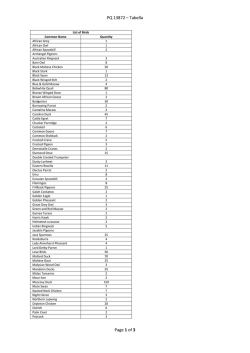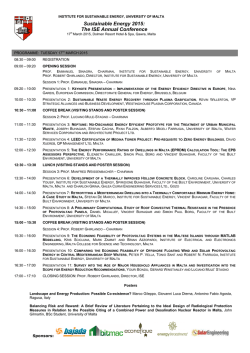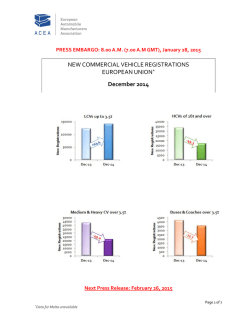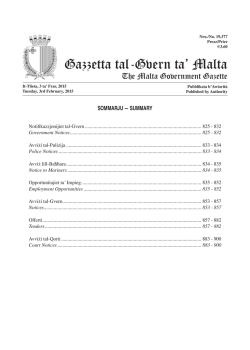
Newsletter 72 - WEBSITE OF THE MALTESE DIASPORA
Maltese Newsletter 72 - February 2015 72 THE MALTESE NEWSLETTER - LINKING THE MALTESE DIASPORA WEBSITE: www.ozmalta.page4.me BANK OF VALLETTA 2015 CALENDAR The BOV Calendar for 2015 acquaints you with Maltese and Gozitan persons who are passionate about traditional culinary delicacies. Their recipes are in the main, as simple as they are genuine. Leafing through the pages of the BOV Calendar, you will find dishes that won’t only make your mouth water, but will certainly open a time window on the culinary culture of our forefathers, the Mediterranean culture, that remained true to its origins along the centuries. Every month opens a window on a world that is almost forgotten beneath the weight of time, and introduces us to individuals who still follow recipes, handed down by their forefathers; recipes that they follow step by step, without fail. The passion they cultivate for this work ensures that they never give in to the temptation of the frenetic pace of today’s life. They still keep these traditions alive, with all their idiosyncrasies. The simplicity of these recipes does not in any way impinge upon their value, on the other hand, it enhances the taste. Perhaps, the most obvious feature that comes across when one goes over this collection is the passion these individuals bring into the preparation, even in the time that they dedicate to realise these dishes, retaining all the delicious and delicate aromas that make them unique. Bank of Valletta chose to focus on this theme because, as the largest Bank in Malta, which grew hand in hand with the Maltese communities, it recognises the importance of solid values and dedication towards one’s work. Over the years, the Bank evolved in order to be better able to serve its clients, both personal and corporate, offering them financial solutions that enable them to grow and realise their potential. Nonetheless, the Bank always remained true to its commitment towards its clients and the Maltese society, and sought to grow with them. This is clear, even in the choice of location for its branches. They are generally found in the core of the village or town, a few metres away from the parish church and the village square – the place where the locals used to meet to exchange a few pleasantries and support one another, in the most simple and genuine manner possible. We trust that this collection of photographs and memories will keep you good company throughout the year, whilst helping you to better appreciate the value of that which is genuinely Maltese. All this makes us what we are today, and helps us better understand the responsibility we have towards building on and safeguarding what we have today, so as to be sure to be in a position to leave an adequate heritage for tomorrow’s generation. This was, is and will remain Bank of Valletta’s vision. https://www.bov.com/ www.ozmalta.page4.me Page 1 Maltese Newsletter 72 - February 2015 Riproduzzjoni ta' fujlett antik bil-mużika tal-Innu u l-versi bil-Malti u l-Ingliż Reproduction of an old manuscript with music of the Maltese Anthem verses in Maltese and English www.ozmalta.page4.me Page 2 Maltese Newsletter 72 - February 2015 JOHN VELLA -AUSTRALIAN/MALTESE ARTIST John Vella on one of his fishing trips. I feel that In your report about the forthcoming Biennale in Mdina Malta (Maltese Newsletter 71), you should have included the name of one of the ‘diasporians’ (second generation). John Vella who as his surname shows is a Maltese Australian has been invited to take part in this years Biennale. John lives in Tasmania and for the last 3 years has been head of the Department of Visual Arts Art &Sculpture) at the University of Tasmania. John studied at the Sydney College of Arts in Sydney which is now part of the University of Sydney and in the last few years he has taken part in National and State exhibitions such as Sculpture by the Sea (Sydney) the Sydney Biennale and in the Multicultural Festival in Canberra with his Terra Towel installation. The latter was also part of the 10 day 'On the Island Festival ' (2011) in Tasmania. HIs work was included in the Melbourne International Arts Festival, (2004) and the Helen Lempriere National Sculpture Award, Werribee Park, Melbourne ( 2003). His solo exhibitions include Place Mats, Apartment and Product Lines , at the Academy Gallery, Launceston, 2002. This is the ‘poles installation’ at the Hobart Airport – Tasmania One of his monumental exhibits is in the approaches to Hobart airport. This consists of a number of high poles cut to various sizes to follow the contours of the mountains in the far background. They are made of shining aluminium and during the day the reflection of the sun and their shadows create a haunting atmosphere. At night the whole set of poles is floodlit which turns the area into a sort of monumental approach to the airport. John has initiated a number of projects in conjunction with high schools . Prominent among these was the one at Hobart where a huge blank wall was covered with thousands of keys from ‘old computer ' key boards. With the play of light and shade it gives the impression of an old mosaic, reminiscent of old mosaic panels. John’s exhibits shows his continuing theme of a disarming and often humorous technique.. We look forward to see and appreciate his exhibit at the forthcoming Internationatonal Biennale in Mdina in the Summer of 2015. Victor Vella, Baulkham Hills N.S.W. MEET JOHN VELLA John Vella was born and raised in Sydney, Australia and moved to Hobart, Tasmania in 1996, where he lives with his wife Sonia, and children Sophia and Vincenzo. Since dropping out of studying architecture in 1988, he has: traveled extensively overseas, worked as a waiter, labourer, photographer, telemarketer, truck loader, phone book factory hand, exhibitions officer, and gallery attendant; completed a DipFA with Distinction (National Art School Sydney), a BFA (Hons) first class and an MFA at the Tasmanian www.ozmalta.page4.me Page 3 Maltese Newsletter 72 - February 2015 School of Art, Hobart. John Vella has developed a number of independent and collaborative art projects across diverse national and international contexts. In addition to having completed five commissions, Vella has received highly competitive grants from the Australia Council and Arts Tasmania. John was up until recently the Head of Sculpture at the Tasmanian College of the Arts where he is currently the Director of Program (Art). His work is represented in private and public collections. John commits acts of physical and conceptual frottage on communities, objects and systems; ‘rubbings’ that recycle the act and artefact of lived experience. Mediating status, value and ‘damage by design’ Vella develops diverse testimonies to the epic and incidental aspects of our personal and material histories. See more at: http://www.situate.org.au/person/john-vella/#sthash.wUFytKXJ.dpuf GETTING MARRIED - BEST ANSWER YET Daughter: " Daddy, I am coming home to get married. Take out your cheque book. Dad, I'm in love with a boy who is far away from me. I am in Australia and he lives in the UK . We met on a dating website, became friends on Facebook, had long chats on Whatsapp, he proposed to me on Skype and now we've had two months of relationship through Viber. Dad, I need your blessings good wishes and a big wedding." Father: "Wow! Really!! Then get married on Twitter, have fun on Tango, buy your kids on Amazon and pay through Paypal. And if you are fed up with your husband....sell him on Ebay". WHY I LIKE THE MALTESE NEWSLETTER? I like this NEWSLETTER because it is non-political, nonreligious, read and enjoyed by thousands of Maltese and non-Maltese all over the world. It is a non-profit gazette and its only aim is to promote the language, heritage, traditions and culture of our beautiful Maltese Islands. Every issue is like having a history lesson not only about Malta, but also about those countries where our Maltese sisters and brothers live. It is amazing how many ‘second and third generation’ young Maltese read regularly this Newsletter. John Camilleri USA www.ozmalta.page4.me Page 4 Maltese Newsletter 72 . - February 2015 VIVA VIVA L-KARNIVAL Kav Joseph M Attard Victoria Ghawdex Għalkemm qsajjar, reġa’ magħna Dan l-imqarqaċ xahar ta’ Frar, Illi skont misserijietna Jingħad li jfawwar il-bjar! Fl-antik niesna kienu jħobbu Jiffullaw għall-Kumittiva; Oħrajn kienu jippreferu Minn mal-arblu jġibu l-priża. Dan ix-xahar dlonk iġib miegħu In-Nawfraġju ta’ San Pawl; Dak l-Appostlu li ġabilna Ta’ twemminna l-akbar dawl. L-għannej Fredu bil-kitarra Ma’ treqatna kien idur Liebes stramb, jgħanni u jqabbel U milqugħ kulfejn imur. Ftit jiem wara jfeġġu fuqna Il-jiem sbieħ tal-Karnival Meta fl-enclosure jinġabru Nisa, rġiel, żgħażagħ u tfal. Tal-Liżar mad-dlam tal-għodwa Biex għal mument wara daharhom Jitfgħu gwaj, problemi w hemm, U jinsew x’għaddej madwarhom – Gwerer, ġlied, tixrid ta’ demm. Kien hemm żmien meta l-Parata Kienet tkun tant mistennija; Fuq l-Istorja tieqa tiftaħ – Xwabel, sjuf, imwiet u dmija! Mal-ibliet u mal-irħula Isaltnu l-bluh u l-ġenn U kulħadd jaqbeż u jiżfen U tad-dar iħalli l-kenn. Bil-Kunsilli jħabirku Spinta ħadna ‘l quddiem; Dawn il-festi m’Għawdex xterdu, Kif jinbidel hux, iż-żmien! Fil-vetrini u fil-ħwienet Tibda tara l-Prinjolata – Lgħabek jinżel xħin idduqha Kollha lewż u ċikkulata. Jalla dawn il-festi jibqgħu Bil-ferħ jimlew qalb in-nies! Basta l-briju u l-allegrija Isiru blghaqal u l-qies. 2015 x Kienu jwerwru n-nies fit-toroq Warajk jiġru, jtuk xi qatgħa “Kma ssibx ruħek taħt ix-xorok! . L-għada, l-aħwa addio ġiri Ma’ wiċċna jfeġġ ir-Randan – Jiem ta’ sawm u astinenza, Neħtiġuh ħbieb żmien bħal dan! This photo depicts the Maltese Carnival in the 60s sent to us by George Brimmer of Malbourne Australia www.ozmalta.page4.me Page 5 Maltese Newsletter 72 Debunking myths on multicultural education In conferences locally and abroad as well as in the current debate over the possible introduction of a multicultural curriculum in the Maltese educational system, I come across widespread myths, misinformation and misconceptions which I would like to share for the benefit of readers and as an eye-opener for policy makers and educational authorities. An all too common misconception is that multicultural education deals with illegal immigrants, the black, the poor or the socially marginalised. Multicultural education is not a social or ethnic specific movement. It is not a 'kind of education' designed for 'others'. When educators hold this view they are only marginalising the entire concept of a muchneeded education for all. Another misconception is that multicultural education would somewhat juxtapose current educational models. Most writers on multicultural education, such as Toni Morrison, Paula Gunn Allen and Maxine Hong, are western writers in no way opposed to western traditions. Multicultural theorists insist that knowledge is perceptual and underpinned by the person's values and experiences, and that knowledge implies action. Consequently, different concepts, theories and paradigms imply different actions. While Malta is polarised in terms of political affiliations, there are many factors that unite www.ozmalta.page4.me - February 2015 the country, including the traditional helping hand for which we are famous all around the world. Multicultural education should not divide our nation but help reformulate what it means to be united. In order to establish a common civic culture that reflects and contributes to the well-being of the entire society we need to participate in the process whereby diverse groups and cultures are reaching beyond their cultural and ethnic borders. Another common misconception is that "it's only about different feasts and holidays". Indeed, many teachers and educational institutions wrongly interpret multiculturalism as a diplomatically correct way not to offend anybody. They therefore miss the essence of what multicultural education really is, that is, raising educators' and students' awareness to various forms of discrimination and injustice which might permeate our educational system. Multicultural education should not be an 'add on' to an already overburdened curriculum but must be viewed as a comprehensive approach that is integrated throughout the whole school culture. It will only receive a fair consideration through properly trained teachers who dedicate themselves towards the well-being of each and every student in their classroom. The real challenge facing education today is the inclusion of multiple perspectives to empower individuals to become more knowledgeable, caring and respectful of multicultural differences. This article is written by Mr Vassallo who is a Masters graduate in educational leadership and management from the University of Leicester, UK. Page 6 Maltese Newsletter 72 - February 2015 FEAST OF SAINT PAUL SHIPWRECKED IN MALTA 10 FEBRUARY This is the day when the entire country of Malta stops in thanksgiving to the Lord for an event that turned our lives around. St Paul brought Christianity to Malta, and it has survived the Romans, the Arabs, the Normans, the Spanish, the French and the British, all of whom had their own beliefs and influences. And yet the Maltese people remained strong in their adherence to their faith. Granted that materialism and consumerism as well as the invasion of social media have taken their toll on many countries in Europe, and Malta, though not unblemished, has withstood the waves that have driven Christianity off the agenda of so many Catholic European countries. I pray this year that Catholicism continues just as strong in the decades to come. Many are the paintings depicting the shipwreck of Saint Paul on the shores of Malta. Quite a few churches and smaller chapels are dedicated to him and many paintings are visible in churches and Museum s. While stranded in Malta for three months, St Paul is said to have stayed in a rock-hewn cave, which is still visible and visited by many tourists, including Pope John Paul II in 1990 and Pope Benedict XVI in 201 0. An artistic statue carved of wood by Melchiore Gafa is carried in procession through the streets of the capital city Valletta on the evening of February 10, and weather permitting, thousands of Maltese faithful will witness this manifestation of faith FATHER JULIAN CASSAR IN USA I was born in Malta from 2 devout parents, the third child between 2 older sisters and 2 younger brothers. I attended school in my native Malta, later on in the major Seminary and the University of Malta and was ordained there on June 19, 1977. I served for 4 years in my own home-town of St Julian’s, until I decided to come to the USA in 1981. Since I grew up in a predominantly Catholic country, I was always exposed to Churches, priests, prayer, etc and so ever since I was a young boy I always wanted to be a priest, serving the people, as I saw the other priests doing. Being an altar-boy since the age of 4 also helped in this, even being chosen to serve at the Vatican in 1966. After serving in various parishes in New York for 22 years, in March 2003, I left the biggest city in the world and ventured out west, ending up in one of the smallest parishes, in John Day, Oregon, with a very small community that were all yearning for involvement, leadership and pastoral care. I enjoyed my time there, especially driving to my mission churches on weekends, a total 130 miles every weekend, even though there would be anywhere between 3 to 15 people in attendance. But I realized that if I did not go to them they would never have a Mass, they would never see a priest. Their churches were small chapels, at times a little trailer, but it was a community and they deserved attention. In June of 2005, the Bishop asked me to take over the Cathedral parish in Baker City, and I right away I embarked on an ambitious project to renovate the sanctuary of the Cathedral, especially since in 2008, the Cathedral would celebrate its centennial. I am happy to share my priesthood with other priests who come from all parts of the world, India, Sri Lanka, Poland, Nigeria, Argentina, Mexico, Tanzania and some from the USA. I felt that God was calling me to dedicate my life to His people, who are my people. I responded for the call by leaving everything, including family, and coming to the USA 4 years after my ordination, realizing that "the world is my parish." My whole life is dedicated to help in building our community into a loving family, and therefore I share all my time with families, children, the youth, our elderly people, couples who have marriage problems, troubled teenagers, and www.ozmalta.page4.me Page 7 Maltese Newsletter 72 - February 2015 everyone who needs a little support from a priest. God never asks us about our abilities or inabilities, but always about our availability - this has been my motto for the past 36 years. My priorities as a priest consist of serving people, being available for them, praying, celebrating the liturgies, planning special celebrations, and communicating with people, through letters, phone-calls, e-mails, and through our parish web-site. A year ago I started a blog sharing reflections, inspirational thoughts and other interesting things that people can relate to and find consolation in. I firmly believe in what Dietrich Bonhoeffer once said, that "the priest should preach with the Bible in one hand and the newspaper in the other." I add further..."and with an IPad, the Internet at arm’s reach and access to e-mail." In this day and age, it is not easy to be a priest. Distractions are many and the challenges are even more. The media presents a priesthood in agony and the numbers of priests is very low. Which means we have to work harder and spread ourselves in many areas and over long hours of the day. But if you are dedicated and committed to what you believe, God will give you the courage and strength to persevere. The people will always love the priest, because, even though he is not perfect, since he's also human, he does his best to present Jesus as a close friend to the people, approachable, joy-filled, spiritually-enriching and friendly. (Kindly check: www.fatherjulian.blogspot.com and SAINT FRANCIS DE SALES CATHEDRAL IN OREGAON USA www.ozmalta.page4.me Page 8 Maltese Newsletter 72 - February 2015 GREAT MALTESE TENOR - PAUL AXIAQ (1923 - ) Paul Asciak was born in Valletta, Malta on January 28, 1923. His talent showed early enough and he spent years of singing in the famed Schola Cantorum at St James Church, Valletta under the direction of Maestro Carlo Diacono one of Malta’s foremost composers. Paul Asciak. Early studio portrait of the tenor. Source: Sandy's Opera Gallery He started taking his first singing lessons with Maltese tenor Nicoló Baldacchino. He made his operatic debut as Turiddu in Mascagni’s Cavalleria Rusticana at the Radio City Opera House in Malta in 1946. In January 1950 after being coached by Mro Luigi Cantoni, Paul Asciak took the role of Radames in Verdi's Aida with the visiting Italian Opera Company "Impresa Cantoni" at the Radio City Opera House in Malta. In the same year Asciak was invited to sing with the visiting famous Italian tenor Tito Schipa and with the renowned Italian soprano Maria Caniglia in March and May respectively. He was encouraged to further his studies by the latter and he went to Rome in March 1950. Caniglia's initiative led to Asciak’s being entrusted to Mro Alberto Paoletti of Rome's Teatro dell'Opera. In 1951 he won the Concorso per Giovani Cantanti Lirici together with, among others, Franco Corelli and Anita Cerquetti. He was granted a bursary for voice and histrionic training under the guidance of Mro Luigi Ricci and Riccardo Picozzi at the Teatro dell'Opera, Rome. In the same theatre's Spoleto production of Aida in 1951, Anita Cerquetti singing the title role, Asciak sang the part of Radames. During his stay in Italy, Paul Asciak sung various roles in various cities throughout Italy. He would have included La Gioconda and Un Ballo in Maschera in his repertoire were it not for the fact that he had to leave Italy and go to London to join the Royal Opera House Covent Garden Company. Asciak was a member of the Royal Opera House Covent Garden Company 1952 to 1954, and as guest artist up to 1958. He appeared over fifty times in various roles such as Melot in Tristan und Isolde, the Tenor Singer in Der Rosenkavalier, Flavio in Norma, Pinkerton in Madama Butterfly and Radames in Aida, apart from other operatic roles. He sang with the Welsh National Opera Company from its very early years, the Dublin Grand Opera, Carl Rosa Opera Company, and others up to 1961. He performed several times on BBC sound and vision as well as on ITV (1952-59). Other leading roles in the UK included Martha, Rigoletto, Il Trovatore, Cavalleria Rusticana, Pagliacci, La Fanciulla del West (BBC TV), Carmen, Balfe’s Bohemian Girl and also the part of Arvino in I Lombardi. Asciak gave numerous concerts and recitals as well as Verdi’s Requiem, mainly in Wales. His guest appearances in Malta at the Radio City Opera House, the Orpheum Theatre, and the Argotti Gardens summer productions were eagerly looked forward to and received much critical acclaim. With visiting Italian companies he sung leading roles in Ernani, Carmen, Aida, Pagliacci, Il Trovatore and Verdi's Otello. It is sad to recall that the last of the three performances of Il Trovatore, held on Sunday 25th November 1959, was the last opera performed in the final season at the Radio City Opera House, Hamrun. www.ozmalta.page4.me Page 9 Maltese Newsletter 72 - February 2015 Asciak retired from the stage in May 1961 and dedicated his time to his family and teaching. He joined the Education Department in 1961 and retired as Head of Department of Music in 1984. In the meantime he was also Director of Music at St Edward's College between 1967 and 1973. Between 1965 and 1988, he was also Honorary Representative of Trinity College of Music, London, for Malta and Gozo. He managed to conserve his voice up to an advanced age. During his term as General Manager at the Manoel Theatre, Malta's National Theatre, he went to Poland in 1989 to engage an opera company for an open air season in Malta. He was asked to replace the tenor in the title role of Verdi's Otello during the dress rehearsal for the first night which was scheduled for the following day. This was the only solution to avoid cancelling the performance. Asciak lent his vast experience to a number of young Maltese singers by teaching them vocal technique and interpretation. In view of the setbacks caused by the second world war, it is surely through his pioneering spirit and that of other singers of the time that so many of today's singers found the courage to pursue their studies abroad. It is undoubtedly with young tenor Joseph Calleja that his name will remain indelibly linked. Asciak has been Calleja's sole tutor, and he still closely follows the increasingly renowned young opera star who is turning out to be one of the most successful Maltese opera singers of all times. DOUBLE-BARRELLED SURNAMES - NOW THE HEIGHT OF FASHION Borg, Camilleri and Vella are most common – a tenth of the population Despite an increasingly mobile population, many surnames still have strong ties to specific localities. Photo: Matthew Mirabelli Amelia Defonseca Torregiani Gomez was the busty, pompous ghost with noble roots in the popular TV series Deċeduti. Her pretentiously long surname, which she insisted on repeating in its entirety, was a running joke among fellow ghosts. But much as doublebarrel surnames – or longer – have often been used to emphasise comical characters in theatrical and television productions, they have also become an ever present reality. In six years double-barrelled surnames increased by 45 per cent, figures out yesterday showed. 45% the percentage increase in double-barrelled surnames in six years Almost 14,000 people had a double-barrelled surname according to the 2011 census, an increase of almost 5,000 over the 2005 census. Of these, almost 3,000 were non-Maltese residents. Mdina, Swieqi, Balzan and Sliema had the highest proportion of residents with double-barrelled surnames, with Gozo standing at the opposite end of the spectrum. Those with a double-barrelled surname tended to be relatively younger, with an average age of 32, compared to 40 for other surnames. The National Statistics Office released a breakdown of surnames recorded in the census. There were 19,104 surnames listed while a tenth of the population had Borg, Camilleri and Vella as their surname. The list of most common surnames was no different from the 2005 census with the top 10 having an identical rank order. www.ozmalta.page4.me Page 10 Maltese Newsletter 72 - February 2015 There are almost 14,000 people with the surname Borg, which remains the most common. Almost a tenth of the Borgs live in Birkirkara. Camilleri comes in at second place with just over 13,000 people having the surname. The highest number of Camilleris live in Mosta. With more than 12,000 people, Vella is the third most com-mon surname with Mellieħa having the highest number. The NSO figures showed a concentration of particular surnames in particular areas. Grech, Farrugia and Spiteri are most likely to be found in Żabbar, Żurrieq and Żejtun respectively. Interestingly, Mintoff ranks 144th at a national level but has the most common cluster in Għasri. Carabott is the third most common surname in Marsaxlokk but it places 94th nationwide. The NSO said such trends indicated that despite an increasingly mobile population, many surnames still had strong ties to specific localities. The three most prevalent foreign surnames were Smith, Jones and Brown with less than 80 people carrying each surname. Pudina tal-Hobz (Bread Pudding) This easy bread pudding recipe from the island of Malta is sure to keep you warm on chilly winter days. Just make yourself some tea or coffee and grab a piece of warm pudina tal-hobz, Maltese for bread pudding. There are many variations of pudding recipes. It seems that pudding is just the right kind of “cake” that you can experiment with to your heart’s content. The recipe on this page is perhaps one of the most commonly used Maltese versions of the bread pudding recipe. Ingredients: 1 large stale Maltese loaf - 1 pkt Sultana - 3 cups of milk - 3 tbsp cocoa powder - 4 tbsp of brown sugar - 1 tsp ground cinnamon - 100 g dark chocolate chopped - 2 eggs - Grated rind of an orange Method: 1. Preheat the oven at a temperature 220C/428F/Gas 7. 2. Grease a 20cm x 20cm square tin and set aside. 3. Tear up the fruit loaf into small chunks and place in a bowl. Add the milk and allow bread to soak for 20 minutes. 4. Add the cocoa, sugar, cinnamon, eggs and orange zest and mix until well combined. Add the chopped chocolate and stir through. 5. Place the bread mixture in the tin and bake in the oven for 30-40 minutes until the top of the pudina is crisp. www.ozmalta.page4.me Page 11 Maltese Newsletter 72 - February 2015 THE ARABS IN MALTA (870 A.D. – 1090 A.D.) The Maltese Islands were still under the Byzantine rule, when the Arabs started their attacks on our Islands, around the year 836 A.D., The Maltese, now Christians, fought hard to defend Malta from the Arab invasion, who were coming from Sicily. Many were the attacks by the Arabs, but the Maltese were successful in warding off their attacks as much. But in the year 870 A.D., Malta was defeated and the Arabs became the rulers. Under the Arabs rules, Islam was introduced as the new religion for the Maltese Islands. Christians practices and public activities were now prohibited. Those who did not declare Mohammed As their Prophet of God, were treated as second-class citizens and were obliged to pay a tribute. The Maltese Islands were now dominated by the Mohammedan. In 991 A.D., census of the Maltese Islands which was ordered by the Emir, gave this result. Muslims...........................14,974 Christians...........................6,342 Some Maltese, without renouncing their Christian religion, had merely acknowledged Mohammed to be the prophet of God, but only to avoid paying the tribute. Despite the spreading of Islam, Malta has remained Christian. The Arabs changed our Islands names from Melita to Malta and from Gaulos to Ghawdex ( Gozo ) and they also gave names to the smaller Islands, one was named Kemmuna ( Comino ) and the other was named Filfla. Names were also given to villages such as Bahrija in Malta and Gharb in Gozo. With two centuries of Arab rule, the Maltese language has been enriched by many Arab words. The citrus fruit, the cultivation of cotton and the water-wheel ( sienja ) were introduced by the Arabs. The cube shape houses with flat roofs and hardly any windows were the Arabs builders style of architecture. The Maltese were prohibited to build houses high as those of the Arabs and could not ride saddled donkeys. The Maltese were also forbidden from carrying any arms. But when the Byzantines were preparing to recapture our Islands, around the year 1048 A.D.. The Arabs were aware that the Maltese would side with the Byzantines, also they were afraid because they have experienced the bravery of the Maltese when they captured our Islands. Therefore, the Emir revoked the order and Kawzuni, the Arab historian, declared. “ Take up arms on our side, if we win you shall be free like ourselves and you will share with us all we possess, if you do not fight, we shall be killed and so will you.” Aided by the Maltese, who were hoping for freedom and so fought bravely, the Arabs defeated the invaders. After the victory, the Arabs treated the Maltese liberally as they promised. There is a well-known saying in Maltese Tkellem bil-Malti jekk tridni nifhmek (Speak Maltese if you want us to understand you). Interestingly, every word of the proverb is of Arabic origin. Today there is a central mosque in Malta and an Islamic cultural centre, which serve as focal points of religious and cultural solidarity for the island’s Muslim community. www.ozmalta.page4.me Page 12 Maltese Newsletter 72 - February 2015 Ggantija Temples, Xaghra, Gozo Older than the Pyramids of Egypt The Ggantija temple complex on the Maltese island of Gozo is recognized as the world's oldest manmade freestanding structure, dating back to approximately the fourth millennium B.C. The awe-inspiring prehistoric complex of Ggantija was erected in three stages, over a period of several hundred years (c. 3600-3000 BC), by the community of farmers and herders inhabiting the small and isolated island of GOZO. It consists of two temple units built side by side, enclosed within a single massive boundary wall and sharing the same facade. This boundary wall incorporates a number of huge blocks measuring over five metres in length and weighing several tonnes. Both temples have a single and central doorway, opening onto a common and spacious forecourt that is, in turn, raised on a high terrace. The temple to the south is both the larger and the older. Its plan consists of a central corridor with two apses on each side and one at the back. The inner pair of apses is the larger and measures 23 metres from end to end. More striking, however, is the undisturbed seven-metre high facade and inner apses. Altar arrangements are preserved in the outer apse right and inner apse left, while the characteristic spiral designs and dotted decorations adorn several architectural elements. Other interesting features include libation holes for liquid offerings, a hearth and a series of four round perforations on each side of the inner door jam to control access. Apart from being smaller and not as old, the temple to the north is also less elaborate. The rear apse has been reduced to a spacious altar niche and no decorative carvings embellish this temple unit. Of particular interest, however, are the finely carved uprights on the inner side of the first pair of apses, modelled on the concave layout of the respective apses. Rituals of life and fertility seem to have been practised within these precincts, while the sophisticated architectural achievements reveal that something really exceptional was taking place in the Maltese islands more than 5,000 years ago. www.ozmalta.page4.me Page 13 Maltese Newsletter 72 - February 2015 Valletta 2018 KANTAKANTUN KantaKantun is an innovative education project led by composer and musician Alex Vella Gregory, allowing students the space to explore the relationship between music and the architecture in their locality. Students from different backgrounds from three secondary schools around Malta and Gozo learn about the often overlooked similarities between music and architecture. Students are encouraged to create their own material through planning and discussion while also learning to structure their ideas coherently. Musical pieces function in the same manner as architecture; both have a third dimension of time and space. A music composer carefully chooses his sounds to subconsciously guide the listener through the musical piece, much like how an architect models a space to make it accessible to the user. Throughout history, a variety of musical compositions have been written by composers inspired by the beauty of architecture. In a similar approach, students produce their own music-making sounds and architectural designs using different musical works of both local and foreign composers as inspiration.They are taught to visualise images, thus linking music to architecture. Malta has an abundance of buildings which are rich in architectural features. With the aid of their teachers and volunteers, students investigate local neighbourhoods to identify these architectural elements. These elements are then accompanied by soundscapes created by the students themselves. This coupling of image and sound constructs a fascinating audio-visual experience. In workshops held throughout the 2014/2015 scholastic year students combine their soundscapes with their architectural designs and formalise and structure the ideas from discussions, sounds and designs using a variety of materials at their disposal. The finished audio-visual works will then be exhibited for public viewing. - See more at: http://valletta2018.org/cultural-programme/kantakantun/#sthash.7hnkcDm6.dpuf www.ozmalta.page4.me Page 14 Maltese Newsletter 72 - February 2015 BIOGRAPHY – FATHER VICTOR VELLA Victor Vella was born to Gregory and Nazzarena VELLA on 8th September 1961 at Victoria, Gozo, the sister island of Malta, being the fourth of five children. In 1978, he commenced his studies for the priesthood in philosophy and theology. He graduated in philosophy at the Pontifical University of St Thomas, Rome, in 1983. After resuming his theological studies at the Sacred Heart Seminary in Gozo and was ordained on 28th June 1986 at the Cathedral in Victoria. Following his ordination, Father Victor was seconded by his Bishop to the archdiocese of Westminster where he served two tenures of curacy in Chiswick and Wembley. Upon being awarded a scholarship to Oxford University in 1988, he studied for a Masters in Philosophy and Political Science whilst residing at Campion Hall – the scholarly residence of the Jesuit Community at Oxford. On completion, he went to the School of Oriental and African Studies (SOAS), University of London, where he gained a postgraduate certificate in comparative politics of the Middle East. In 1991, Fr Victor was seconded to the archdiocese of Southwark to serve two tenures of curacy in West Croydon and Beckenham. He was appointed parish priest of Our Lady of the Assumption, Northfleet, in April 1997. Whilst serving the parish, he pursued his interest in study by pursuing courses in Biblical Hebrew at Heythrop College and University College London (UCL). After serving ten years as a parish priest, he decided to take a study sabbatical in 2007 to deepen his knowledge in Biblical Hebrew and New Testament Greek at the Pontifical Institute of Biblical Studies, whilst residing at the Venerable English College in Rome before moving to Jerusalem for his second academic term. It was during his sojourn there that he was appointed parish priest to Holy Innocents', Orpington. On 7th November 2008, Father Victor was inducted by the Right Reverend Patrick Lynch, Auxiliary Bishop of Southwark. Father Victor remains very keen on Judaism and Biblical Hebrew. To mark his twenty fifth anniversary of ordination, he returned to Jerusalem in June/July 2011, to undertake a course in biblical studies at Bat Kol Institute. (A centre founded in 1983 for the study of the Word of God within its Jewish milieu, using Jewish sources, ancient and modern, with the help of Jewish and Christian scholars.). Araw daqsxejn kif qed niktbu: Bejbi – baby, plejer – player, spiker – speaker, cermen – chairman, bajsikil- bicycle, kejk – cake, garaxx – garage, maws – mouse - kompjuter – computer, erkondixin – aircondition, gowl – goal, erport- airport, imejlemail www.ozmalta.page4.me Page 15 Maltese Newsletter 72 - February 2015 World's longest flight record-holder, QANTAS 'City of Canberra' 747-400, retires The flight crew from the record-breaking Qantas flight in 1989. Photo: Qantas Qantas is donating the aircraft, also known as "City of Canberra" to the Historical Aircraft Restoration Society (HARS), as flagged by Fairfax Media earlier this month. The facility is home to the largest collection of both flying and static heritage aircraft in Australia, including an old Qantas Lockheed Super Constellation. Qantas chief executive Alan Joyce said it was important for such an iconic aircraft to be on display as a reminder of the role Qantas had played in aviation history. "Qantas has been responsible for a lot of aviation firsts and many of them have centred on endurance and reliability," he said. "The record breaking flight of this Boeing aircraft was a technical and symbolic achievement because it showed what was possible with the latest generation of aircraft and that spirit of innovation still drives us today." The flight in 1989 required the plane to minimise weight and use a special high-density fuel. While it was categorised as a commercial flight, the jumbo carried only 23 people, including the crew. Deputy Premier and Minister for Tourism and Major Events Troy Grant said VH-OJA would be a boon for regional tourism in the state. "Coffs Harbour has the big banana, Ballina has the big prawn, and now thanks to Qantas, Shellharbour has the big Boeing 747," he said. www.ozmalta.page4.me Page 16 Maltese Newsletter 72 - February 2015 Gaulitanus Choir holds Annual General Meeting BY GOZO NEWS · JANUARY 23, 2015 http://gozonews.com/ The official year for the Gaulitanus Choir ended with its Annual General Meeting. Apart from the presentation of the different official reports, the well-attended AGM discussed various matters for the good of the choir. Following the AGM, as per the choir’s statute, the founder-director and choir’s chair appointed a team of consultants. These are: Josianne Callus-Executive Secretary (responsible also for finances); Marvic Bajada – deputy chair; Stephanie Buttigieg – internal auditor; Annabelle Zammit – assistant to executive secretary; Rev. Fr Joseph Calleja and Carole Mclaren Meanwhile non-chorister Silvana Cini and chorister Deborah Portelli remain webmistress and o/i/c facebook respectively. Meanwhile non-chorister Silvana Cini and chorister Deborah Portelli remain webmistress and o/i/c facebook respectively. 2014 was Malta’s third hottest year on record – MIA Last year was Malta’s third hottest year on record, with an average annual temperature of 19.88°C, according to the Malta Airport Met Office today. Since records began in 1923, the heat recorded last year was only exceeded twice before: in 2001 (19.94°C) and 1999 (19.90°C). Last year was also brighter, drier and less windy than the average for Malta, it said. The hottest month of the year was September, which also happened to be the hottest month on record, with average temperature soaring beyond 34°C. Meanwhile, December was the coldest with average temperature dropping to 7.7°C, and a rare form of precipitation appearing in the form of snow pellets. The hottest day was August 14, when the mercury soared to 34.7°C, while the coldest day was December 31, when temperatures dropped to 2.8°C – this was the second coldest day ever recorded in Malta since 1923. On the whole, Malta enjoyed an average of 8.4 hours of sunshine each day, exceeding the daily average norm by 0.4 hours. The brightest month was July, enjoying an average of 11.77 hours of bright sunshine and the clearest blue skies, with an average cloud cover of 1.3 oktas. The dullest month was December, seeing only an average of 5.51 hours of sunshine and March the cloudiest, reaching an average of 4.4 oktas. Between January and December, there was less rainfall and less wind than what is usually experienced average of 4.4 oktas. Between January and December, there was less rainfall and less wind than what is usually experienced across Malta. Total rainfall registered was 504.3mm, 48.7mm below the yearly average of 553mm. In total, 34 days of thunder were recorded, 9 days of fog and 6 days of hail. www.ozmalta.page4.me Page 17 Maltese Newsletter 72 - February 2015 A COURTESY VISIT OF AN AUSTRALIAN/MALTESE BUSINESSMAN TO THE MALTA HIGH COMMISSION CANBERRA 21 January 2015 Photo: H. E. Charles Muscat Malta High Commissioner and Mr. Charles Figallo Managing Director of Basetec Services – South Australia MALTA ENTERPRISE www.maltaenterprise.com Note: Malta – A strategic location for business in the Middle East LURA FIŻ-ŻMIEN – IL-MALTIN FL-AWSTRALJA Ironikament it-tmiem tal-gwerra dinjija kien il-kawża ta’ qgħad kbir f’pajjiżna. Bosta ħaddiema sfaw bla xogħol u wħud ma rawx għażla aħjar minn dik li jħallu lil art twelidhom biex imorru jfittxu xortihom f’pajjiż ieħor. Il-kontinent Awstraljan kien wieħed minn dawk illokalitajiet li laqa’ għandu numru kbir ta’ emigranti Maltin. Hekk jew hekk fl-Awstralja kien hemm bżonn kbir ta’ nies biex jaħdmu u jippopolaw il-pajjiż. Kienet okkażżjoni f’waqtha li kienet qed toffri ċċans lill-Maltin biex jgħixu f’pajjiż tant differenti b’artijiet bla tarf, bi ħlejqiet uniċi u bi staġuni strambi. Imma eventwalment l-Awstralja kienet dak il-pajjiż tal-ħolm? Jiena trabbejt nisma’ r-rakkonti t’ommi Angela meta spiss kont nismagħha ssemmi żżminijiet li għexet fl-Awstralja. Barra minn hekk, peress li wieħed minn ħutha kien għadu jgħix hemmhekk, mhux darba u tnejn li n-nanna Fortunata u z-zija Gracie talbuni biex niktbilhom xi ittra ħalli jibgħatuhielu. Niftakar li kienu ittri li kollha jibdew l-istess “Għażiż Ġużeppi, Vera u t-tfal, nispera li tinsabu tajbin bħal kif ninsabu aħna għall-grazzja t’Alla”. Kont tgħallimt nikteb l-introduzzjoni bl-amment u kont nitbissem meta nara li dejjem kienu jiktbulu l-istess ħaġa. Ilbqija tal-ittri kienu jikkonsistu f’dak li jkunu għaddew minnu matul dawk l-aħħar ġimgħat jew dwar xi ħaġa li kienu beħsiebhom jagħmlu. Ta’ tifla li kont, ftit stajt napprezza dawk l-ittri ripetittivi imma sforz ir-rispett lejn qrabati kont niktibhomlhom bl-aħjar kaligrafija li stajt nikteb biha u bi preċiżjoni eżatt ta’ kif kienu jiddettawhomli. Kellhom jgħaddu ħafna snin qabel fhimt kemm kienu jfissru għalihom dawk il-karti ċelesti li kont niktbilhom l-ittri fuqhom u għaliex kienu jistennew ir-risposti tagħhom tant b’ħerqa. U forsi kien dan it-tnebbiħ li llum wassalni biex www.ozmalta.page4.me Page 18 Maltese Newsletter 72 - February 2015 naqsam magħkom l-esperjenza li għaddiet minnha ommi meta ta’ 18 il-sena ddeċidiet li tħalli pajjiżha sabiex tagħti lok għall-ħolma tagħha… “Tnejn minn ħuti s-subien kienu ddeċidew li jmorru lejn l-Awstralja biex ifittxu xogħol u ħajjruni mmur magħhom. Ommi xejn ma ħadet pjaċir b’din l-aħbar u missieri rriffjuta li jiffirmali l-karti biex insiefer peress li kont għadni taħt l-età. Imma inzerta li ftit wara għalaqt it-18 il-sena u allura ħija l-kbir Ġużeppi rnexxielu jikkonvinċi lil missieri li kien ser jieħu ħsiebi hu. Wegħdu li ser iġib ruħu daqs li kieku kien it-tieni missier tiegħi u kelmtu żammha għax id-dixxiplina tiegħu kienet iebsa mhux ħażin! Tlaqna tliet aħwa f’daqqa minn familja sħiħa: jiena u ħija Indrì u ħija Ġużeppi flimkien mal-familja tiegħu peress li kien miżżewweġ.” Ommi niftakarha qed tipprepara l-bagalji b’eċċitament kbir. “Bsart li ser nimmissja lill-ġenituri tiegħi u lil ħuti imma ta’ żagħżugħa li kont neħħejt dawk il-ħsibijiet minn quddiem għajnejja u minflok intfajt noħlom dwar dik l-opportunità sabiħa li ngħix u naħdem f’pajjiż ieħor. Ma kont qed nara xejn ħlief dak il-vapur sabiħ li kellna nirkbu u li kellu jeħodna lejn l-Awstralja! Qabel tlaqt ommi għafsitni magħha u reġgħet qaltli li ma xtaqitnix immur. Il-ħsieb talfirda minni kien diġà qed ikiddha u talbitni biex ma ninsihiex u biex ma nibqax hemm. “Erġa’ ejja ‘l hawn, tinsinix!” lissnet waqt li bdiet ixxejjirli. ”Hemm ħafna kieku xi ssemmi. Imma tgħid aħna minsijin għax meqjusa bħala Maltin tal-Awstralja?” (Nota: Dan l-artiklu ġie ppubblikat fit- Torċa tat-12 ta’ Settembru 2010) FIONA VELLA http://fionavella.com/ www.ozmalta.page4.me Page 19
© Copyright 2026







